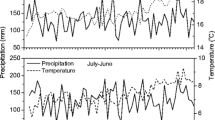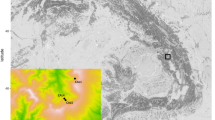Abstract
Lowland forests in Central Kalimantan, Indonesian Borneo, are endangered by land conversion and the increasing frequency of severe drought. Knowledge of the tolerance of tropical trees to drought is urgent for the management of these lowland habitats. The short-term effects of drought on tree demography (mortality and growth) were investigated in an ever-wet riparian peat-swamp forest and a heath forest on coarse sandy soil after the 1997 El Niño Southern Oscillation (ENSO) event. This drought was unusually severe because little rain fell during the following rainy season. However, forest-wide mortality following the drought (1997–1999) was not critically high in the peat-swamp (6.13% yr−1) or heath (4.26% yr−1) forest. In both forests, standing trees frequently died during the dry season following the drought. The riparian peat-swamp forest was not flooded until 1998, after the prolonged drought in 1997. The hummock–hollow microtopography resulted in differential mortality of peat-swamp trees. On tall hummocks, standing death increased two-fold (4.99% yr−1) during the dry season, whereas uprooting decreased by one-third (0.85% yr−1) during the following rainy season. In contrast, tree growth was not affected by hummock height. Common canopy species were concentrated on tall hummocks and died standing more often than did understory species found in hollows, indicating species-specific mortality after the drought. The large stand basal area relative to the forest-wide growth rate in diameter suggested less resilience to drought by peat-swamp (45.6 m2 ha−1 and 0.0186 ln[cm] yr−1) than heath (27.9 m2 ha−1 and 0.0232 ln[cm] yr−1) forest. A single severe drought did not cause dramatic changes in the peat-swamp and heath forests; however, an increasing frequency of droughts similar in severity to that of the 1997 ENSO event may have the potential to alter the community structure and dynamics, leading to a consistent decline in Bornean lowland forests.
Similar content being viewed by others
References
Anderson JAR (1961) The ecology and forest types of the peat swamp forests of Sarawak and Brunei in relation to their silviculture. Ph.D. Thesis, Edinburgh University, Edinburgh, UK
Aplet GH, Hughes RF, Vitousek PM (1998) Ecosystem development on Hawaiian lava flows: biomass and species composition. J Veg Sci 9:17–26
Ashton PS (1993) The community ecology of Asian rain forests in relation to catastrophic events. J Biosci 18:501–514
Ashton PS, Hall P (1992) Comparisons of structure among mixed dipterocarp forests of north-western Borneo. J␣Ecol 80:459–481
Becker P (1996) Sap flow in Bornean heath and dipterocarp forest trees during wet and dry periods. Tree Physiol 16:295–299
Becker P, Castillo A (1990) Root architecture of shrubs and saplings in the understory of a tropical moist forest in lowland Panama. Biotropica 22:242–249
Cao KF (2000) Water relations and gas exchange of tropical saplings during a prolonged drought in a Bornean heath forest, with reference to root architecture. J Trop Ecol 16:101–116
Clinebell HRR, Phillips OL, Gentry AH, Stark N, Zuuring H (1995) Prediction of neotropical tree and liana species richness from soil and climatic data. Biodivers Conserv 4:56–90
Coomes DA (1997) Nutrient status of Amazonian caatinga forests in a seasonally dry area: nutrient fluxes in litter fall and analysis of soils. Can J Forest Res 27:831–839
Coomes DA, Grubb PJ (1996) Amazonian caatinga and related communities at La Esmeralda, Venezuela: forest structure, physiognomy and floristics, and control by soil factors. Vegetatio 122:167–191
Coomes DA, Grubb PJ (1998) Responses of juvenile trees to above- and belowground competition in nutrient-starved Amazonian rain forest. Ecology 79:768–782
Cuevas E, Medina E (1988) Nutrient dynamics within Amazonian forests II. Fine root growth, nutrient availability and leaf litter decomposition. Oecologia 76:222–235
Duivenvoorden JF (1996) Patterns of tree species richness in rain forests of the middle Caqueta area, Columbia, NW Amazonia. Biotropica 28:142–158
Gentry AH (1982) Patterns of neotropical plant species diversity. Evol Biol 15:1–84
Gentry AH (1988) Changes in plant community diversity and floristic composition on environmental and geographic gradients. Ann Miss Bot Gard 74:205–233
Gilbert GS, Harms KE, Hamill DN, Hubbell SP (2001) Effects of seedling size, El Niño drought, seedling density, and distance to nearest conspecific adult on 6-year survival of Ocotea whitei seedlings in Panamá. Oecologia 127:509–516
Givnish TJ (1999) On the causes of gradients in tropical tree diversity. J Ecol 87:193–210
Grubb PJ (1977) Control of forest growth and distribution on wet tropical mountains: with special reference to mineral nutrition. Ann Rev Ecol Systemat 8:83–107
Haraguchi A, Shimada S, Takahashi H (2000) Distribution of peat and its chemical properties around Lahi in the catchment of the Mangkutup River, Central Kalimantan. Tropics 10:265–272
Miyamoto K, Suzuki E, Kohyama T, Seino T, Mirmanto E, Simbolon H (2003) Habitat differentiation among tree species with small-scale variation of humus depth and topography in a tropical heath forest of Central Kalimantan, Indonesia. J Trop Ecol 19:1–13
Nishimura TB, Suzuki E (2001) Allometric differentiation among tropical tree seedlings in heath and peat-swamp forests. J Trop Ecol 17:667–681
Paciorek CJ, Condit R, Hubbell SP, Foster RB (2000) The demographics of resprouting in tree and shrub species of moist tropical forest. J Ecol 88:765–777
Page SE, Siegert F, Rieley JO, Boehm HDV, Jaya A, Limin S (2002) The amount of carbon released from peat and forest fires in Indonesia during 1997. Nature 420:61–65
Reich PB, Peterson DW, Wedin DA, Wrage K (2001) Fire and vegetation effects on productivity and nitrogen cycling across a forest—grassland continuum. Ecology 82:1703–1719
Richards PW (1996) The tropical rain forest, 2nd edn. Cambridge University Press, Cambridge UK
Sack L, Grubb PJ (2002) The combined impacts of deep shade and drought on the growth and biomass allocation of shade-tolerant woody seedlings. Oecologia 131:175–185
Sheil D, Burslem DFRP, Alder D (1995) The interpretation and misinterpretation of mortality rate measures. J Ecol 83:331–333
Specht A, Specht RL (1993) Species richness and canopy productivity of Australian plant communities. Biodivers Conserv 2:152–167
Turner IM, Lucas PW, Becker P, Wong SC, Yong JWH, Choong MF, Tyree MT (2000) Tree leaf form in Brunei: A heath forest and a mixed dipterocarp forest compared. Biotropica 32:53–81
Tyree MT, Patiño S, Becker P (1998) Vulnerability to drought-induced embolism of Bornean heath and dipterocarp forest trees. Tree Physiol 18:583–588
Vose R, Schmoyer R, Steurer P, Peterson T, Heim R, Karl T, Eischeid J (1992) The global historical climatology network: long-term monthly temperature, precipitation, sea level pressure, and station pressure data. Carbon Dioxide Information Analysis Center Oak Ridge National Laboratory, Oak Ridge TN USA
Whitmore TC (1984) The tropical rain forest of the Far East, 2nd edn. Clarendon Press, Oxford UK
Wright SJ (1992) Seasonal drought, soil fertility and the species density of tropical forest plant communities. Trend Ecol Evol 7:260–263
Acknowledgments
We thank H. Simbolon of the Herbarium Bogoriense for managing the research, and S. Limin, S. Gumiri, and S. Jaya of the University of Palangka Raya for valuable suggestions and assistance with field measurements. We also thank the Bureau of Science and Technology Cooperation of the Indonesian Institute of Science (LIPI) for permission to perform the research. This study was supported by the Core University Project between Hokkaido University and the Research and Development Centre for Biology, under the auspices of the Japan Society for the Promotion of Science (JSPS) and LIPI, and by the 1997–1998 International Scientific Research Program of the Ministry of Education, Culture and Sports of Japan.
Author information
Authors and Affiliations
Corresponding author
Additional information
An erratum to this article can be found at http://dx.doi.org/10.1007/s11258-007-9266-0
Rights and permissions
About this article
Cite this article
Nishimua, T., Suzuki, E., Kohyama, T. et al. Mortality and Growth of Trees in Peat-swamp and Heath Forests in Central Kalimantan After Severe Drought. Plant Ecol 188, 165–177 (2007). https://doi.org/10.1007/s11258-006-9154-z
Received:
Accepted:
Published:
Issue Date:
DOI: https://doi.org/10.1007/s11258-006-9154-z




